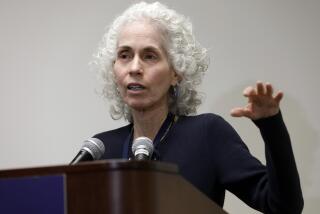Economy has some hospitals in dire straits
Hospitals across California and the country are reeling from the effects of the economic downturn and the troubled financial markets.
Patients are putting off medical care because of job losses, job insecurity and high out-of-pocket expenses. As a result, the number of paying patients and profitable elective procedures is down. At the same time, the number of uninsured patients whom hospitals treat is rising.
Like just about everybody else, hospitals are losing money on their investments. To operate, they need to regularly borrow money. Yet now, when they need working capital the most, the credit markets are all but frozen.
And in California, low Medi-Cal reimbursements for poor patients and the state budget crisis are making matters worse.
The latest complications follow a dozen years during which more than 70 hospitals closed in California, and there is concern that some may not pull through this downturn.
“We’ve got a number of hospitals that are absolutely on the brink,” said Jan Emerson, spokeswoman for the California Hospital Assn.
Financial analysts and insiders expect the turmoil to accelerate a shakeout.
“The weaker hospitals will continue to get weaker in a bad economy, and the stronger hospitals will find a way to survive and build market share,” said Chris Van Gorder, chief executive of Scripps Health, a nonprofit chain of five hospitals in San Diego County.
Most alarming to hospital administrators, healthcare advocates and patients are the financial, economic and government crises all hitting at once.
Hospitals are facing a “triple whammy,” said Anthony Wright, executive director of Health Access California, a patient advocacy organization. “You have the healthcare safety net seeing more uninsured people in the system at the same time employers are scaling back coverage. At the same time, the state is seeking to further cut healthcare programs.”
Just about every hospital is affected in one way or another.
At Cedars-Sinai Medical Center in Los Angeles, financial counselors are dealing with a surge in patients with high-deductible health insurance who are unable to pay their share of the bill.
In Oceanside, Tri-City Medical Center is struggling to plug a reported $400,000-a-month hole blown in its budget by the sudden escalation of the cost of its debt.
And in Northern California, NorthBay Healthcare closed a $15-million projected shortfall by shuttering a pediatric hospital unit and an outpatient pediatric rehabilitation program with a waiting list of 100 children.
“It was a tearful closing, but we only saw more cuts coming down the line,” said Steve Huddleston, director of public affairs for NorthBay of Fairfield, Calif. “We didn’t see any light at the end of the tunnel.”
Two-thirds of hospitals nationwide report experiencing a decline since July in elective procedures, which tend to be profit centers, according to a recent survey by the American Hospital Assn. Overall admissions also are down at more than a third of hospitals, reversing a long upward trend.
The care patients are putting off might be elective, but it isn’t trivial.
At Cedars, for instance, “we have seen people putting off elective but important procedures, such as colonoscopies,” hospital spokeswoman Elise Anderson said.
Jon Marcus, a self-employed San Francisco resident, said he postponed surgery for sleep apnea last month because he faced a $5,000 deductible.
“If the deductible wasn’t so high, I would have done it right away,” he said.
With mounting job losses, more people without insurance are going without regular medical care until crises hit. That’s adding to emergency room demand. In California, a third of hospitals report experiencing a rise in the number of uninsured patients in emergency rooms since the downturn began, according to a recent survey of hospital financial executives by the state hospital association.
At UCLA Medical Center, emergency room visits have increased 25% since July. David Feinberg, UCLA’s chief medical officer, said that was driven by job losses and the closure of other hospitals.
Dr. James Leo, associate chief medical officer at Long Beach Memorial Medical Center, said his emergency room had adopted new strategies to ensure that the sickest patients get priority.
Hospitals are big business. The nation’s hospitals treated 121 million people in emergency rooms in 2007. And they employ 4.7 million people, nearly twice as many as those in U.S. automotive manufacturing and sales, government figures show.
So even a hiccup in the hospital sector can reverberate through the economy. And this is no hiccup. Half the hospitals responding to the national survey said they were reconsidering or had postponed new construction and renovation projects. Kaiser Permanente, for instance, said it was delaying the openings of hospitals in Vacaville and Vallejo.
Broad losses in stocks are shrinking hospitals’ rainy day funds.
“It’s a huge financial mess right now,” said Rob Fuller, chief operating officer of Downey Regional Medical Center. “I go around and kick the Coke machines regularly to see if any quarters fall out.”
If the state government starts writing IOUs again instead of paying what it owes hospitals, it could plunge many into a cash crisis. Normally, hospitals would turn to credit markets to tide them over until the state paid up.
But the prospect of state IOUs during a credit freeze is truly chilling, Fuller said. “That scares me the most.”
In recent years, employers have slowed the rate of increase in their healthcare expenses by shifting costs onto workers through higher deductibles and reduced benefits. As a result, patients are responsible for a bigger portion of their hospital bills. So more patients are unable to pay their portion of their bills. Three out of four hospitals surveyed by the California association said they had experienced a rise in the number of patients who have insurance but are unable to pay their out-of-pocket expenses.
At NorthBay’s VacaValley and Fairfield hospitals, the value of such uncollectable bills rose to $6 million in December, up from $1 million in July. “It happened at an alarming rate,” Huddleston said.
“We’re not just seeing an increase in the number of people walking into the emergency room who can’t pay, but we’re seeing an increase in people who have health insurance with high deductibles and can’t afford to pay those deductibles,” he said. “They come in and say, ‘I’ve got a $2,500 annual deductible. I know I have cancer, but I can’t make this payment.’ ”
Many hospitals are trying to hang on by dropping or reducing service lines. Pediatrics, obstetrics and psychiatric wards are common targets, and many hospitals are reducing emergency-room capacity.
Hospitals nationwide also are laying off workers, recording more mass layoffs in 2008 than in any other year in a decade, government figures show.
Hospital layoffs hurt patient care, said Rose Ann DeMoro, executive director of the California Nurses Assn. She said hospital systems also were beginning to ask for concessions, such as cuts in retirement and sick leave benefits, from organized labor.
“There’s been a crisis for quite a while, but it’s escalating with the downturn of the economy at a very rapid rate,” DeMoro said. “What the nurses see is that it is tragic in the lives of patients and their families.”
--
mark.medina@latimes.com
More to Read
Sign up for Essential California
The most important California stories and recommendations in your inbox every morning.
You may occasionally receive promotional content from the Los Angeles Times.











